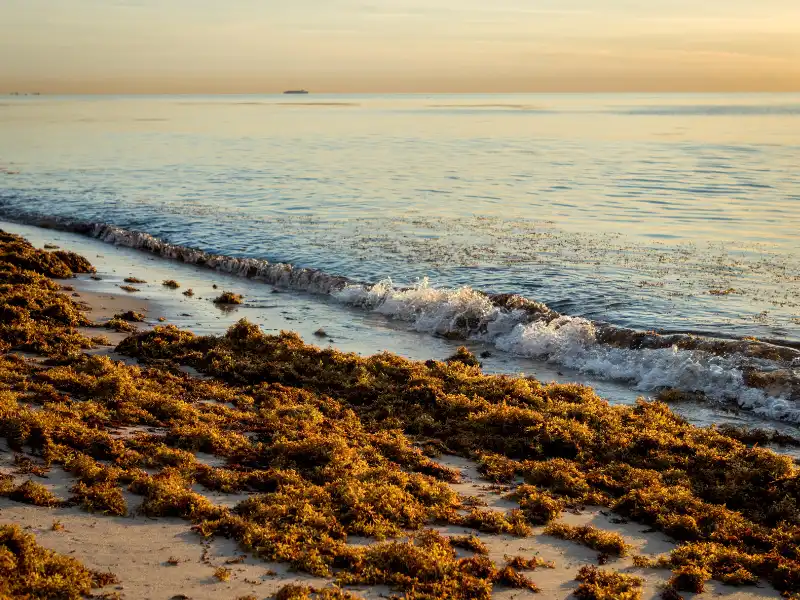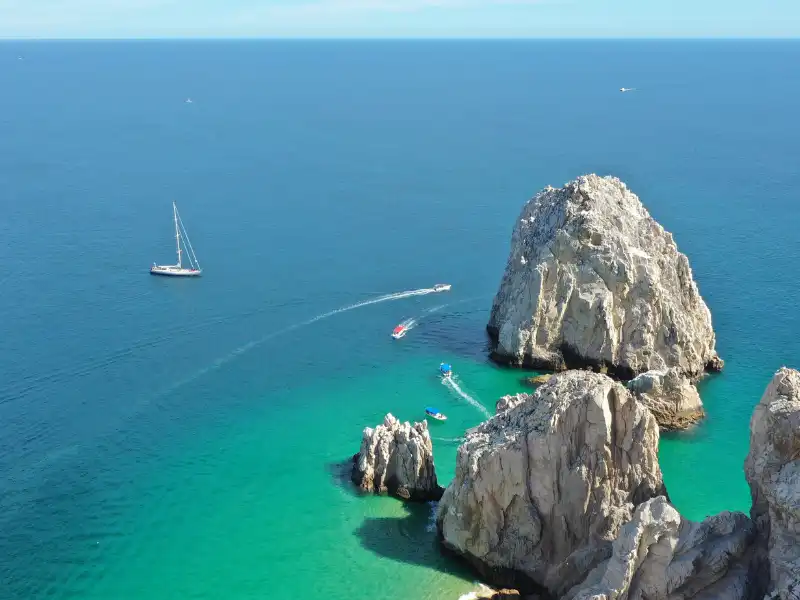If you want to know whether Cabo and Puerto Vallarta have a seaweed problem like Cancun and Tulum then you have come to the right place.
In this article, we have detailed information about everything you should know about the seaweed and seaweed conditions in Cabo and Puerto Vallarta before you plan a visit to these destinations.
Currently, most of the Caribbean countries and Mexico’s top travel destinations like Cancun, Playa del Carmen, and Tulum are facing a huge sargassum crisis.
The Sargassum situation began in the Caribbean in 2011. It became a real problem in 2018 and has since been a nuisance that is often hard to predict due to changing ocean currents.
Researchers cite various reasons for the rapid expansion of sargassum over the past ten years. These include deforestation, climate change/warmer ocean currents, runoff from agricultural nitrogen-rich fertilizers, oceanic chemical change, and sewage waste
Do Cabo & Puerto Vallarta have Seaweed Problems?
Table of Contents
What is a Seaweed Problem?

Sargassum is a type of seaweed produced naturally thousands of miles away in the sargasso sea. It is considered that sargassum is a result of the increased use of fertilizers and chemicals, which find their way from rivers into the sea, as well as climate change and the warming of the ocean.
The sargassum belt stretches across the Atlantic Ocean from West Africa to the Gulf of Mexico. This huge sargassum belt enters the Gulf of Mexico in the summer months due to strong winds and ocean currents.
However, the important thing to understand is that sargassum is not a problem when it is in the open sea. On the contrary, it soaks up carbon dioxide and provides a vital habitat for fish, crabs, shrimp, other marine fauna, turtles, and also birds.
However, once it lands on the beaches, sargassum seaweed becomes a huge problem for everyone.
When it lands on the shoreline, Sargassum begins to rot after 48 hours on the beaches, releasing foul-smelling hydrogen sulfide and choking (literally and figuratively) the local tourist industry. It also destroys the local marine habitat and drastically impacts fishing operations.
Unfortunately, Mexico and other Caribbean countries have been facing a huge sargassum problem since 2018. Especially, Mexico’s top tourist destinations like Cancun, Playa del Carmen, and Tulum are most affected by this problem.
Is Sargassum seaweed dangerous to humans?
As I explained earlier, sargassum seaweed is usually harmless to humans when it is on water. However, once it reaches the beaches, it begins to rot. Sargassum decomposes into stinging thick layers on the surface of the water, depleting the oxygen in the water and destroying the marine life in the area.
This rotting seaweed’s huge heaps detract from the beauty of pristine beaches, and its rotten egg odor makes water activities and swimming nearly impossible and extremely uncomfortable.
Do Cabo & Puerto Vallarta have a Seaweed Problem?
Fortunately, Cabo & Puerto Vallarta don’t have a seaweed problem like Cancun and Tulum. Both, Cabo and Puerto Vallarta are completely free from the sargassum seaweed problem.
Now, let me explain why these destinations have such contrasting fates even after being from the same country.
Mexico has two beautiful coastlines: The Caribbean coastline to the east and the Pacific coastline to the west. Cabo San Lucas and Puerto Vallarta are located on the Pacific coast of Mexico while Cancun, Tulum, and Playa del Carmen are located on the Caribbean coast.
The important thing to understand is that the sargassum seaweed problem is limited to only the Caribbean coastline of Mexico. Every year usually in the summer season huge sargassum influxes enter the Caribbean Ocean and ruin the beaches on Mexico’s Caribbean coastline.
That’s why Cancun, Tulum, and Playa del Carmen tackle the sargassum problem every year. On the other hand, Cabo and Puerto Vallarta, which are located on the Pacific coast, remain completely seaweed-free.
Related posts
Punta Cana SEAWEED Problem [2023]: Everything You Need To Know!!
Jamaica Seaweed Problem 2023 [Updated]: Everything You Need To Know!
Aruba SEAWEED Problem (2023): Everything You Need To Know!!
Puerto Rico Seaweed Problem 2023: Everything You Need to Know!
Bermuda Seaweed Problem 2023: All You Need To Know Before Visiting!
Cabo/Puerto Vallarta Vs. Cancun/Tulum: Which is better for vacation in 2023?
If you are a beach lover who is looking to visit Mexico in 2023, we recommend you to visit Cabo/Puerto Vallarta over Cancun/Tulum/Playa del Carmen.
As per recent reports, the 2023 sargassum season is expected to be as worse as the one in 2022. Unfortunately, the mass of sargassum has grown to record levels this year, weighing thirteen million tons and covering five thousand five hundred miles, which is a huge problem for tourists who are planning a trip to Mexico and beaches on the Caribbean side.
In fact, Cancun, Tulum, and Playa del Carmen have been continuously receiving huge sargassum influxes since the beginning of February 2023. And, the problem is expected to become bad to worse in the coming months.
So, if you are planning a visit to Cabo & Puerto Vallarta, you don’t have to worry about the seaweed problem. You will find clean, beautiful, and completely seaweed-free beaches for entire years on both of these destinations.
In fact, recently the National Certification Institute of Mexico has awarded Cabo for the cleanest and most sustainable beaches in Mexico.
Conclusion
Cabo and Puerto Vallarta are completely sargassum-free destinations. Both Cabo and Puerto Vallarta are undoubtedly one of the best seaweed-free destinations in Mexico to visit for tourists in 2023.
That’s why since 2022 more and more tourists are choosing Cabo and Puerto Vallarta over Cancun and Tulum to avoid the sargassum problem on Mexico’s Caribbean coastline.
However, keep in mind that you won’t get the Caribbean vibe in Cabo and Puerto Vallarta as they are located on the Pacific coast.
